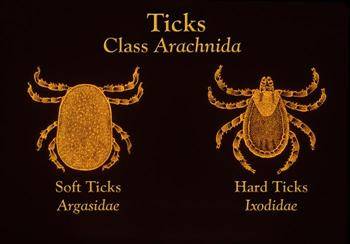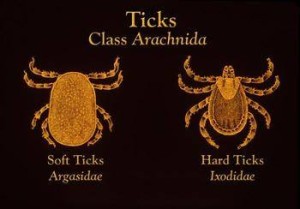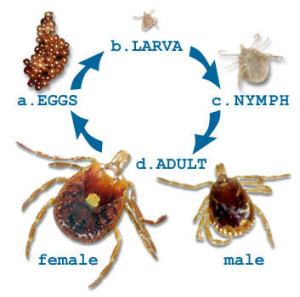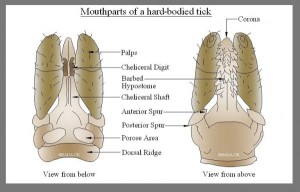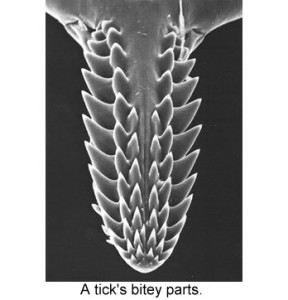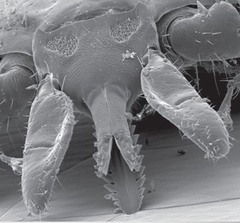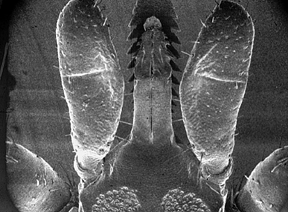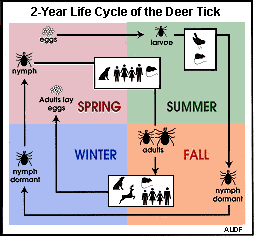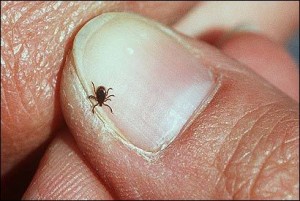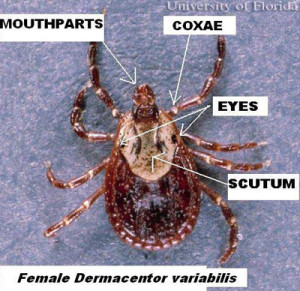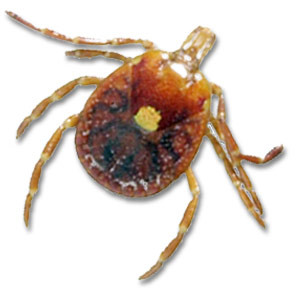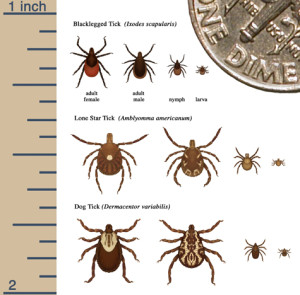Tick Information | Classification – Tick Control Company
Ticks are arachnids. Although they resemble insects, they are actually more closely related to spiders and mites. They have 8 legs (except as larvae) and lack wings, true eyes and visible body segments. They cannot fly or jump, and spend most of their lives waiting for the next blood meal — often in a quiescent state under the leaf litter. They are parasitic, in that their only food source is a living animal.
Ticks are the original ninjas. They use cunning and chemicals to overcome the host species’ defenses. Neurotoxins, vasodilators, and anticoagulants are some of the many chemicals that they inject to aid in feeding, along with possible pathogens. Their barbed mouthparts make them difficult to dislodge or remove while they are attached and actively feeding.
Check out this video of how a tick feeds:
[media width=”400″ height=”225″ link=”http://youtu.be/aJHjUMZVRKA”]
As you can see from the photograph, above, the mouthparts of ticks are serrated and barbed. This helps to keep them securely fastened to the host animal during feeding and difficult to dislodge until they are ready to let go. The two outer members are their palps, or sensory organs, with which they find their meals.
Ticks are divided into two categories, the soft and hard ticks. Soft ticks (Argasidae) are mainly parasites of birds, and are rarely encountered. Hard ticks (Ixodidae) are parasites of terrestrial animals, predominately mammals and reptiles.
Ticks go through several developmental stages through their lives. They start out as larvae, molt into nymphs (some species have several nymphs stages), and eventually emerge as adults (males and females). Their stage and gender play an important part in assessing the risk of disease transmission.
Each life stage requires a blood meal, and ticks have different strategies for finding their meal. One is actively searching, or “questing” from foliage, which is what most of the hard ticks do. The other is passively waiting around in the hosts’ nests — the way most soft ticks feed. Although ticks can actively quest for extended periods of time, they spend most of their lives under the leaf-litter in a quiescent state, digesting their previous meal and preparing to molt into the next developmental stage.
Many ticks are host-specific in their adult stage, which means that they have a preferred animal for their final meal. This is to maximize the chances of finding a mate and reproducing successfully. In their immature stages, they feed on small mammals or reptiles. Some of these small mammals have been found to be the source of many of the diseases that ticks transmit to us and our domestic animals.
There are many species of ticks, and they differ by geographic location. Not all ticks are carrying disease and not all species of ticks are capable of transmitting disease to us, even if they are carrying it. Here in the Northeast, the ticks of most concern are:
Ixodes scapularis – the black-legged, or deer tick
Dermacentor variabilis – the American dog tick, or wood tick
Amblyomma americanum – the lone star tick
We will discuss each of these ticks individually, giving you essential information about them that you need to know to protect yourself against their bites and diseases that they might be carrying.
Although tick identification appears to be simple using cards like the one displayed below, it is very important to know that ticks change dramatically after feeding and do not resemble the images that you see on these cards.


